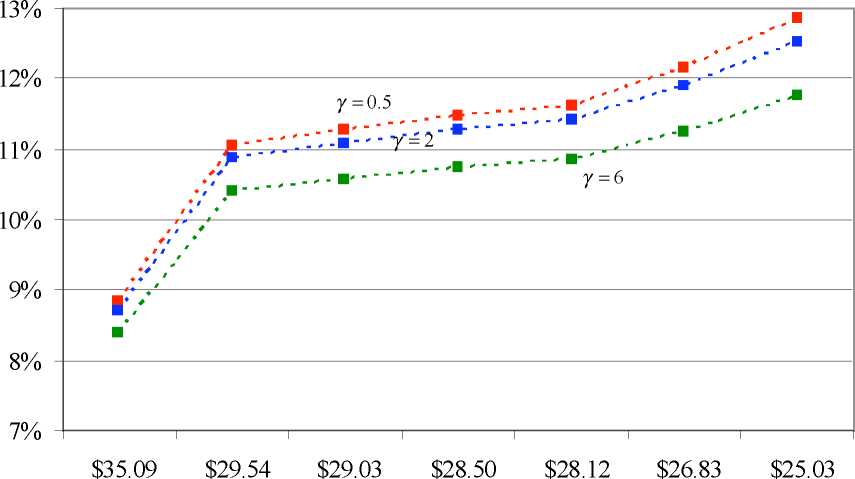Current Agriculture, Food & Resource Issues
M. Doyon, C. Brodeur and J-P. Gervais

Figure 2 Maximum discount rate of production quotas that entails no participation in the IEM
program for deliveries in May 2001 when average variable costs are $16 per hl.
between the export contract and the average variable cost, is decreasing with the export
price. The latter two observations imply that the grid search algorithm is sensible to the
choice of parameters and that it can be unstable. This remark becomes particularly
relevant in instances in which the most profitable contract available is priced below the
average variable cost. Under this condition, the optimization problem is degenerate since
the net return of the risk-free asset is negative.
Figure 2 illustrates the impact of producers’ efficiency on the maximum discount
rates. Consider a hypothetical producer that produces milk at a constant average variable
cost of $16 per hl. A decrease in average variable costs in the model has the same
interpretation as a positive change in the initial wealth of the producer. In the current
portfolio allocation model, production is fixed and the difference between the domestic
price and marginal cost does not explain the valuation of production quotas by producers.
Although costs do not directly explain quota values holding production fixed, they have a
significant wealth effect with respect to the allocation of milk deliveries by producers.5
Constant relative risk preferences imply decreasing absolute risk aversion. In other words,
as wealth increases, a producer will become less risk averse. The maximum annual
discount rate of a producer that entails no participation in the individual export milk
program ranges from 8.4 percent to 8.8 percent depending on the producer’s preferences
towards risk, given that the most profitable export contract is $35.09 per hl. If the most
126
More intriguing information
1. Motivations, Values and Emotions: Three Sides of the same Coin2. Uncertain Productivity Growth and the Choice between FDI and Export
3. The name is absent
4. Strategic Effects and Incentives in Multi-issue Bargaining Games
5. Accurate and robust image superresolution by neural processing of local image representations
6. BUSINESS SUCCESS: WHAT FACTORS REALLY MATTER?
7. Estimating the Technology of Cognitive and Noncognitive Skill Formation
8. Improvements in medical care and technology and reductions in traffic-related fatalities in Great Britain
9. Apprenticeships in the UK: from the industrial-relation via market-led and social inclusion models
10. Government spending composition, technical change and wage inequality